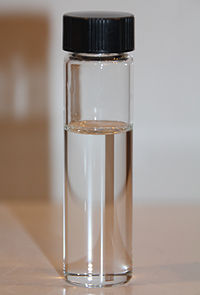
Photo from wikipedia
Abstract The inability to economically transport ethane from distributed shale gas production sites results in the “rejection”, i.e. flaring or reinjection, of this important petrochemical feedstock. Therefore, a technology capable… Click to show full abstract
Abstract The inability to economically transport ethane from distributed shale gas production sites results in the “rejection”, i.e. flaring or reinjection, of this important petrochemical feedstock. Therefore, a technology capable of efficiently converting geographically isolated ethane into transportable liquid fuels would effectively exploit this abundant yet wasted resource. We proposed a modular ethane-to-liquids (M−ETL) system that employs a chemical looping-oxidative dehydrogenation (CL-ODH) scheme to convert ethane into olefins via cyclic redox reactions. The olefins would subsequently undergo oligomerization to form mid-distillate liquid fuels. In this study, a sodium molybdate promoted CaTi0.1Mn0.9O3 core-shell redox catalyst (CaTi0.1Mn0.9O3@Na2MoO4) is presented as a potentially viable, redox-active catalyst for the CL-ODH of ethane to ethylene. Performance data were collected from 1,600 + hours (>4,000CL-ODH cycles) of packed bed operations at varying temperatures and space velocities. 52 – 58% single-pass olefin yields at 725 and 730 °C were obtained with relatively low (2.5 – 8%) COx selectivity. The experimental data were used as inputs to an ASPEN Plus® based M−ETL system model to evaluate its performance. Sensitivity analyses were performed on the CL-ODH and oligomerization sections of the M−ETL system, and the results were used to inform economic analysis of the process. The techno-economic analysis (TEA) indicates that the introduction of recycle to the system provides flexibility for profit generation for both high (Xethane = 0.75) and low (Xethane = 0.58) conversion cases. Additionally, TEA results demonstrate that electrical cogeneration can be economically attractive under certain scenarios.
Journal Title: Chemical Engineering Journal
Year Published: 2021
Link to full text (if available)
Share on Social Media: Sign Up to like & get
recommendations!